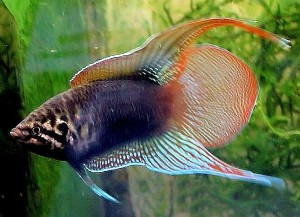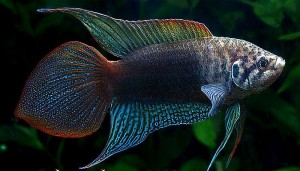The Round Tailed Paradise Fish (Macropodus Ocellatus) is also known to tropical fish keeping enthusiasts as the Chinese Paradise Fish and is found throughout China, Korea, Japan, and probably northeastern Vietnam between the Zhu Jiang (Pearl River) in southern China and the Heilong Jiang (Amur River) at the northeastern China, Russian border. There are also populations in the Russian portion of the Amur basin which are believed to have been artificially introduced.
Round Tailed Paradise Fish are frequently collected from irrigation ditches, marshes, rice paddies, pools, streams, and slow moving backwaters of larger rivers.
This species is extremely adaptable and during the winter months, temperatures across some of its natural range often drop well below zero, resulting in frozen water surfaces and water temperatures as low as 37°F. They thrive in colder, still or slow moving water with dense vegetation and can be seen swimming under the ice in some parts of their range.
Unlike other species of paradise fish, Macropodus ocellatus has a round, red tail with white flecks. The body is colored a charcoal grey with white stripes on the head.
They have enormously extended dorsal and anal fins that are colored red and yellow. The tips of these fins can go well beyond the end of their caudal fins.
The eye stripe is a not connecting spot on the posterior projection of the opercle with the eye and the posterior tips or margins of their body scales are not any darker than the color of the scales.
Males are larger than females, have much darker colors, and possess extended soft rays in their dorsal, anal, and caudal fins. Females are more of a beige color and have shorter fins, but are otherwise similar in appearance to the males.
Round Tailed Paradise Fish behave identically to Macropodus Opercularis, except that they are slightly less aggressive to their own kind and prefer cooler water temperatures. Several specimens can be kept together as a group in a large aquarium without incident but kept alone, it is not a trustworthy candidate for a community tank. When choosing tank mates, it is important to keep in mind the lower temperatures that these fish require. Keeping them in pairs or small groups is the preferred option.
Macropodus ocellatus are best kept in a densely planted, 30 gallon or larger aquarium with a fine gravel substrate, some rock work and/or driftwood for them to hide among, and some floating plants
. The water temperature in the tank should not exceed 75 degrees F. and their tank should be allowed to cool down to around 50 degrees F. for several months of the year to mimic their natural habitat.
Round Tailed Paradise Fish are bubble nest builders and can be bred in the same manner as Macropodus Opercularis. Soft water with a slightly raised temperature is said to induce spawning activity and a tightly fitting cover for the tank is necessary to create a layer of warmer humid air that is necessary for the development of the labyrinth organ in the fry.
When a conditioned pair is ready to breed, the male will construct a bubble nest among the surface vegetation. The female is normally tolerated during the building of the nest and once the nest is complete, the male will entice the female by displaying his elongated dorsal, anal, and caudal fins.
The female will become paler and the typical spawning “embrace” commences under the nest. The male wraps his body around the female until some milt and a few eggs are released. The eggs contain a globule of oil which allows them to float upwards into the nest however, the male will usually help out the process by gathering the fertilized eggs into his mouth and placing them in the bubble nest. The process is repeated several times until the female is spent and several hundred eggs are deposited into the nest.
After spawning is completed and as long as sufficient cover is provided, the female can be left in the tank to help guard the eggs. The eggs will hatch in 3 to 4 days and the fry will remain in the nest until their egg sacs are absorbed and they become free swimming. At this point the adults should be removed from the breeding tank and the fry should be fed infusoria until they are able to accept microworms or newly hatched baby brine shrimp. Frequent small water changes should be performed during the rearing process.
Because of their extreme tolerance to cold, Round Tailed Paradise Fish are often kept in ponds throughout the world. It is important not to release them into the wild as they could easily survive, breed, and become a potential invasive species.
In their natural habitat, Round Tailed Paradise Fish prey on insect larvae, small crustaceans and small fish. In an aquarium environment, they will eagerly accept live, frozen, or freeze dried Daphnia, brine shrimp, white worms, tubifex and a quality omnivore flake food.
Macropodus Ocellatus are a strikingly beautiful species that are rarely available to tropical fish keeping enthusiasts. They are sometimes available online from importers and European breeders and are moderately priced.
Minimum Tank Size: 30 gallons
Care Level: Easy
Temperament: Mildly Aggressive
Aquarium Hardiness: Hardy
Water Conditions: 50-72° F, 6-10 dKH, pH 6.0-7.5
Max Size: 3.1″
Color Form: Gray, Beige
Diet: Omnivore
Compatibility: OK community tank
Origin: Asia, Russia
Family: Osphronemidae
Lifespan: 3-5 years
Aquarist Experience Level: Intermediate




